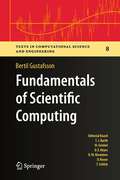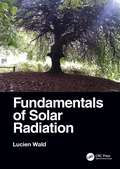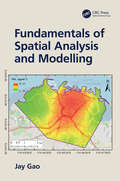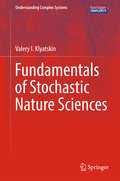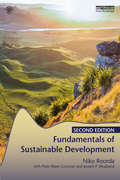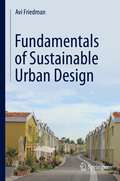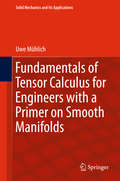- Table View
- List View
Fundamentals of Satellite Remote Sensing: An Environmental Approach, Second Edition
by Emilio ChuviecoFundamentals of Satellite Remote Sensing: An Environmental Approach, Second Edition is a definitive guide to remote sensing systems that focuses on satellite-based remote sensing tools and methods for space-based Earth observation (EO). It presents the advantages of using remote sensing data for studying and monitoring the planet, and emphasizes co
Fundamentals of Satellite Remote Sensing: An Environmental Approach, Third Edition
by Emilio ChuviecoFundamentals of Satellite Remote Sensing: An Environmental Approach, Third Edition, is a definitive guide to remote sensing systems that focuses on satellite-based remote sensing tools and methods for space-based Earth observation (EO). It presents the advantages of using remote sensing data for studying and monitoring the planet, and emphasizes concepts that make the best use of satellite data. The book begins with an introduction to the basic processes that ensure the acquisition of space-borne imagery, and provides an overview of the main satellite observation systems. It then describes visual and digital image analysis, highlights various interpretation techniques, and outlines their applications to science and management. The latter part of the book covers the integration of remote sensing with Geographic Information System (GIS) for environmental analysis. This latest edition has been written to reflect a global audience and covers the most recent advances incorporated since the publication of the previous book, relating to the acquisition and interpretation of remotely sensed data. New in the Third Edition: Includes additional illustrations in full color. Uses sample images acquired from different ecosystems at different spatial resolutions to illustrate different interpretation techniques. Includes updated EO missions, such as the third generations of geostationary meteorological satellites, the new polar orbiting platforms (Suomi), the ESA Sentinels program, and high-resolution commercial systems. Includes extended coverage of radar and LIDAR processing methods. Includes all new information on near-ground missions, including unmanned aerial vehicles (UAVs). Covers new ground sensors, as well as machine-learning approaches to classification. Adds more focus on land surface characterization, time series, change detection, and ecosystem processes. Extends the interactions of EO data and GIS that cover different environmental problems, with particular relevance to global observation. Fundamentals of Satellite Remote Sensing: An Environmental Approach, Third Edition, details the tools that provide global, recurrent, and comprehensive views of the processes affecting the Earth. As one of CRC’s Essential titles, this book and stands out as one of the best in its field and is a must-have for researchers, academics, students, and professionals involved in the field of environmental science, as well as for libraries developing collections on the forefront of this industry.
Fundamentals of Satellite Remote Sensing: An Environmental Approach, Third Edition
by Emilio ChuviecoFundamentals of Satellite Remote Sensing: An Environmental Approach, Third Edition, is a definitive guide to remote sensing systems that focuses on satellite-based remote sensing tools and methods for space-based Earth observation (EO). It presents the advantages of using remote sensing data for studying and monitoring the planet, and emphasizes concepts that make the best use of satellite data. The book begins with an introduction to the basic processes that ensure the acquisition of space-borne imagery, and provides an overview of the main satellite observation systems. It then describes visual and digital image analysis, highlights various interpretation techniques, and outlines their applications to science and management. The latter part of the book covers the integration of remote sensing with Geographic Information System (GIS) for environmental analysis. This latest edition has been written to reflect a global audience and covers the most recent advances incorporated since the publication of the previous book, relating to the acquisition and interpretation of remotely sensed data. New in the Third Edition: Includes additional illustrations in full color. Uses sample images acquired from different ecosystems at different spatial resolutions to illustrate different interpretation techniques. Includes updated EO missions, such as the third generations of geostationary meteorological satellites, the new polar orbiting platforms (Suomi), the ESA Sentinels program, and high-resolution commercial systems. Includes extended coverage of radar and LIDAR processing methods. Includes all new information on near-ground missions, including unmanned aerial vehicles (UAVs). Covers new ground sensors, as well as machine-learning approaches to classification. Adds more focus on land surface characterization, time series, change detection, and ecosystem processes. Extends the interactions of EO data and GIS that cover different environmental problems, with particular relevance to global observation. Fundamentals of Satellite Remote Sensing: An Environmental Approach, Third Edition, details the tools that provide global, recurrent, and comprehensive views of the processes affecting the Earth. As one of CRC’s Essential titles, this book and stands out as one of the best in its field and is a must-have for researchers, academics, students, and professionals involved in the field of environmental science, as well as for libraries developing collections on the forefront of this industry.
Fundamentals of Satellite Remote Sensing
by Emilio Chuvieco Alfredo HueteAn extensive review of remote sensing principles with an emphasis on environmental applications, Fundamentals of Satellite Remote Sensing discusses a wide range of topics, from physical principles to data acquisition systems and on to visual and digital interpretation techniques. The text focuses on the interpretation and analysis of remo
Fundamentals of Scientific Computing (Texts in Computational Science and Engineering #8)
by Bertil GustafssonThe book of nature is written in the language of mathematics -- Galileo Galilei How is it possible to predict weather patterns for tomorrow, with access solely to today’s weather data? And how is it possible to predict the aerodynamic behavior of an aircraft that has yet to be built? The answer is computer simulations based on mathematical models – sets of equations – that describe the underlying physical properties. However, these equations are usually much too complicated to solve, either by the smartest mathematician or the largest supercomputer. This problem is overcome by constructing an approximation: a numerical model with a simpler structure can be translated into a program that tells the computer how to carry out the simulation.This book conveys the fundamentals of mathematical models, numerical methods and algorithms. Opening with a tutorial on mathematical models and analysis, it proceeds to introduce the most important classes of numerical methods, with finite element, finite difference and spectral methods as central tools. The concluding section describes applications in physics and engineering, including wave propagation, heat conduction and fluid dynamics. Also covered are the principles of computers and programming, including MATLAB®.
Fundamentals of Seismic Loading on Structures
by Tapan K. SenThis book provides a practical guide to the basic essentials of earthquake engineering with a focus on seismic loading and structural design. Benefiting from the author’s extensive career in structural and earthquake engineering, dynamic analysis and lecturing, it is written from an industry perspective at a level suitable for graduate students. Fundamentals of Seismic Loading on Structures is organised into four major sections: introduction to earthquakes and related engineering problems, analysis, seismic loading, and design concepts. From a practical perspective, reviews linear and non-linear behaviour, introduces concepts of uniform hazard spectra, discusses loading provisions in design codes and examines soil-structure interaction issues, allowing the reader to quickly identify and implement information in a working environment. Discusses probabilistic methods that are widely employed in the assessment of seismic hazard, illustrating the use of Monte Carlo simulation with a number of worked examples. Summarises the latest developments in the field such as performance-based seismic engineering and advances in liquefaction research. “There are many books on earthquake engineering, but few are of direct use to the practising structural designer. This one, however, offers a new perspective, putting emphasis on the practical aspects of quantifying seismic loading, and explaining the importance of geotechnical effects during a major seismic event in readily understandable terms. The author has succeeded in marrying important seismological considerations with structural engineering practice, and this long-awaited book will find ready acceptance in the profession.” Professor Patrick J. Dowling CBE, DL, DSc, FIStructE, Hon MRIA, FIAE, FREng, FRS Chairman, British Association for the Advancement of Science Emeritus Professor and Retired Vice Chancellor, University of Surrey
Fundamentals of Shallow Water Acoustics (The Underwater Acoustics Series)
by Boris Katsnelson Valery Petnikov James LynchShallow water acoustics (SWA), the study of how low and medium frequency sound propagates and scatters on the continental shelves of the worlds oceans, has both technical interest and a large number of practical applications. Technically, shallow water poses an interesting medium for the study of acoustic scattering, inverse theory, and propagation physics in a complicated oceanic waveguide. Practically, shallow water acoustics has interest for geophysical exploration, marine mammal studies, and naval applications. Additionally, one notes the very interdisciplinary nature of shallow water acoustics, including acoustical physics, physical oceanography, marine geology, and marine biology. In this specialized volume the authors, all of whom have extensive at-sea experience in US and Russian research efforts, have tried to summarize the main experimental, theoretical, and computational results in shallow water acoustics, with an emphasis on providing physical insight into the topics presented.
Fundamentals of Soils
by John GerrardFundamentals of Soil provides a comprehensive and engaging introduction to soils and the workings of soil systems. This text is the only one of its kind to provide an attractive, lively and accessible introduction to this topic. Featuring learning tools within each chapter, such as summaries, essay questions and guides for further reading, the text is also highly illustrated with useful tables, boxes and figures. Covering all key areas of study at an introductory level, subjects covered include:· Soil properties· Soil processes· Controls on soil formation· Soil classification· World soils· Soil patterns· Soil degradation.
Fundamentals of Soils
by John GerrardFundamentals of Soil provides a comprehensive and engaging introduction to soils and the workings of soil systems. This text is the only one of its kind to provide an attractive, lively and accessible introduction to this topic. Featuring learning tools within each chapter, such as summaries, essay questions and guides for further reading, the text is also highly illustrated with useful tables, boxes and figures. Covering all key areas of study at an introductory level, subjects covered include:· Soil properties· Soil processes· Controls on soil formation· Soil classification· World soils· Soil patterns· Soil degradation.
Fundamentals of Solar Radiation
by Lucien WaldThe sun radiates a tremendous amount of energy, called solar energy or solar radiation, which is the main natural source of energy on the Earth, by far. Because solar radiation is the almost unique supplier of energy to the Earth, it has a primary influence on life and activities on the Earth. The climate is a first example, but there are many others, such as plant growth or human health, or even the design of buildings, the production of energy, notably electrical and thermal, or even aging materials. This book aims to provide simple answers to anyone who has questions about solar radiation. Its ambition is to help by presenting the fundamental elements of the solar radiation received on the ground. The book includes many examples and numerous illustrations, as well as some simple but fairly precise equations to calculate the various elements covered and to reproduce the figures and graphs. The first of the three parts of this book is devoted to the relative geometry between the direction of the sun and an observer on the ground as well as to the solar radiation emitted by the sun and received at the top of the atmosphere. The orbit of the Earth around the sun and the solar declination are described. The concept of time is introduced which is closely linked to the solar cycle and the rotation of the Earth on itself. Equations are given to calculate the solar radiation received on a horizontal or inclined surface located at the top of the atmosphere. The spectral distribution of the extraterrestrial solar radiation is described. The second part of this book addresses how the solar radiation incident at the top of the atmosphere is attenuated and modified in its downward path to the ground. The reflection of the radiation by the ground is presented. The solar radiation received on the ground by a horizontal or inclined collector plane, such as a natural slope or a rooftop, is discussed, as well as its spectral distribution. The variability of the radiation is addressed in relation to the properties of solar radiation estimated from the measurements. The third part deals with direct or indirect measurements of the solar radiation received on the ground over a given integration time (minute, hour, day, or month), whether for total radiation or radiation in a spectral range such as ultraviolet (UV), or daylight, or photosynthetically active radiation (PAR). It also explains how to check the plausibility of the measurements. Fundamentals of Solar Radiation will be a valuable resource to all professionals, engineers, researchers, students, and other practitioners that seek an understanding of solar radiation.
Fundamentals of Solar Radiation
by Lucien WaldThe sun radiates a tremendous amount of energy, called solar energy or solar radiation, which is the main natural source of energy on the Earth, by far. Because solar radiation is the almost unique supplier of energy to the Earth, it has a primary influence on life and activities on the Earth. The climate is a first example, but there are many others, such as plant growth or human health, or even the design of buildings, the production of energy, notably electrical and thermal, or even aging materials. This book aims to provide simple answers to anyone who has questions about solar radiation. Its ambition is to help by presenting the fundamental elements of the solar radiation received on the ground. The book includes many examples and numerous illustrations, as well as some simple but fairly precise equations to calculate the various elements covered and to reproduce the figures and graphs. The first of the three parts of this book is devoted to the relative geometry between the direction of the sun and an observer on the ground as well as to the solar radiation emitted by the sun and received at the top of the atmosphere. The orbit of the Earth around the sun and the solar declination are described. The concept of time is introduced which is closely linked to the solar cycle and the rotation of the Earth on itself. Equations are given to calculate the solar radiation received on a horizontal or inclined surface located at the top of the atmosphere. The spectral distribution of the extraterrestrial solar radiation is described. The second part of this book addresses how the solar radiation incident at the top of the atmosphere is attenuated and modified in its downward path to the ground. The reflection of the radiation by the ground is presented. The solar radiation received on the ground by a horizontal or inclined collector plane, such as a natural slope or a rooftop, is discussed, as well as its spectral distribution. The variability of the radiation is addressed in relation to the properties of solar radiation estimated from the measurements. The third part deals with direct or indirect measurements of the solar radiation received on the ground over a given integration time (minute, hour, day, or month), whether for total radiation or radiation in a spectral range such as ultraviolet (UV), or daylight, or photosynthetically active radiation (PAR). It also explains how to check the plausibility of the measurements. Fundamentals of Solar Radiation will be a valuable resource to all professionals, engineers, researchers, students, and other practitioners that seek an understanding of solar radiation.
Fundamentals of Spatial Analysis and Modelling
by Jay GaoThis textbook provides comprehensive and in-depth explanations of all topics related to spatial analysis and spatiotemporal simulation, including how spatial data are acquired, represented digitally, and spatially aggregated. Also features the nature of space and how it is measured. Descriptive, explanatory, and inferential analyses are covered for point, line, and area data. It captures the latest developments in spatiotemporal simulation with cellular automata and agent-based modelling, and through practical examples discusses how spatial analysis and modelling can be implemented in different computing platforms. A much-needed textbook for a course at upper undergraduate and postgraduate levels.
Fundamentals of Spatial Analysis and Modelling
by Jay GaoThis textbook provides comprehensive and in-depth explanations of all topics related to spatial analysis and spatiotemporal simulation, including how spatial data are acquired, represented digitally, and spatially aggregated. Also features the nature of space and how it is measured. Descriptive, explanatory, and inferential analyses are covered for point, line, and area data. It captures the latest developments in spatiotemporal simulation with cellular automata and agent-based modelling, and through practical examples discusses how spatial analysis and modelling can be implemented in different computing platforms. A much-needed textbook for a course at upper undergraduate and postgraduate levels.
Fundamentals of Spatial Information Systems
by Robert Laurini Derek ThompsonThe study and application of spatial information systems have been developed primarily from the use of computers in the geosciences. These systems have the principle functions of capturing, storing, representing, manipulating, and displaying data in 2-D and 3-D worlds. This book approaches its subject from the perspectives of informatics and geography, presenting methods of conceptual modeling developed in computer science that provide valuable aids for resolving spatial problems. This book is an essential textbook for both students and practitioners. It is indispensable for academic geographers, computer scientists, and the GIS professional. - Serves as the first comprehensive textbook on the field of Spatial Information Systems (also known as Geographic Information Systems) - Contains extensive illustrations - Presents numerous detailed examples
Fundamentals of Spherical Array Processing (Springer Topics in Signal Processing #16)
by Boaz RafaelyThis book provides a comprehensive introduction to the theory and practice of spherical microphone arrays, and was written for graduate students, researchers and engineers who work with spherical microphone arrays in a wide range of applications. The new edition includes additions and modifications, and references supplementary Matlab code to provide the reader with a straightforward start for own implementations. The book is also accompanied by a Matlab manual, which explains how to implement the examples and simulations presented in the book.The first two chapters provide the reader with the necessary mathematical and physical background, including an introduction to the spherical Fourier transform and the formulation of plane-wave sound fields in the spherical harmonic domain. In turn, the third chapter covers the theory of spatial sampling, employed when selecting the positions of microphones to sample sound pressure functions in space. Subsequent chapters highlight various spherical array configurations, including the popular rigid-sphere-based configuration. Beamforming (spatial filtering) in the spherical harmonics domain, including axis-symmetric beamforming, and the performance measures of directivity index and white noise gain are introduced, and a range of optimal beamformers for spherical arrays, including those that achieve maximum directivity and maximum robustness are developed, along with the Dolph–Chebyshev beamformer. The final chapter discusses more advanced beamformers, such as MVDR (minimum variance distortionless response) and LCMV (linearly constrained minimum variance) types, which are tailored to the measured sound field.
Fundamentals of Statistical Hydrology
by Mauro NaghettiniThis textbook covers the main applications of statistical methods in hydrology. It is written for upper undergraduate and graduate students but can be used as a helpful guide for hydrologists, geographers, meteorologists and engineers. The book is very useful for teaching, as it covers the main topics of the subject and contains many worked out examples and proposed exercises. Starting from simple notions of the essential graphical examination of hydrological data, the book gives a complete account of the role that probability considerations must play during modelling, diagnosis of model fit, prediction and evaluating the uncertainty in model predictions, including the essence of Bayesian application in hydrology and statistical methods under nonstationarity.The book also offers a comprehensive and useful discussion on subjective topics, such as the selection of probability distributions suitable for hydrological variables. On a practical level, it explains MS Excel charting and computing capabilities, demonstrates the use of Winbugs free software to solve Monte Carlo Markov Chain (MCMC) simulations, and gives examples of free R code to solve nonstationary models with nonlinear link functions with climate covariates.
Fundamentals of Stochastic Nature Sciences (Understanding Complex Systems)
by Valery I. KlyatskinThis book addresses the processes of stochastic structure formation in two-dimensional geophysical fluid dynamics based on statistical analysis of Gaussian random fields, as well as stochastic structure formation in dynamic systems with parametric excitation of positive random fields f(r,t) described by partial differential equations. Further, the book considers two examples of stochastic structure formation in dynamic systems with parametric excitation in the presence of Gaussian pumping. In dynamic systems with parametric excitation in space and time, this type of structure formation either happens – or doesn’t! However, if it occurs in space, then this almost always happens (exponentially quickly) in individual realizations with a unit probability.In the case considered, clustering of the field f(r,t) of any nature is a general feature of dynamic fields, and one may claim that structure formation is the Law of Nature for arbitrary random fields of such type. The study clarifies the conditions under which such structure formation takes place. To make the content more accessible, these conditions are described at a comparatively elementary mathematical level by employing ideas from statistical topography.
Fundamentals of Sustainable Aviation (ISSN)
by Eva MalevitiFundamentals of Sustainable Aviation is the first textbook to survey the critical field of sustainability within the aviation industry. Taking a systems thinking approach, it presents the foundational principles of sustainability and methodically applies them to different aviation sectors.Opening with the basics of sustainability, emphasising the Sustainable Development Goals, the book then considers the environmental, economic and social dimensions of aviation. The following chapters apply these insights to aviation design, supply chains, operations, maintenance and facilities. The final chapter examines the concept of resilience in sustainable aviation. Overall, the textbook shows how future sustainability can be achieved by making better decisions today.Students are supported with international case studies throughout the book. Slides, test questions and a teaching manual are available for instructors. This textbook is the ideal resource for courses on sustainable aviation globally and will also be of great interest to professionals in the field.
Fundamentals of Sustainable Aviation (ISSN)
by Eva MalevitiFundamentals of Sustainable Aviation is the first textbook to survey the critical field of sustainability within the aviation industry. Taking a systems thinking approach, it presents the foundational principles of sustainability and methodically applies them to different aviation sectors.Opening with the basics of sustainability, emphasising the Sustainable Development Goals, the book then considers the environmental, economic and social dimensions of aviation. The following chapters apply these insights to aviation design, supply chains, operations, maintenance and facilities. The final chapter examines the concept of resilience in sustainable aviation. Overall, the textbook shows how future sustainability can be achieved by making better decisions today.Students are supported with international case studies throughout the book. Slides, test questions and a teaching manual are available for instructors. This textbook is the ideal resource for courses on sustainable aviation globally and will also be of great interest to professionals in the field.
Fundamentals of Sustainable Development
by Niko RoordaThe impact of development needs to be considered beyond the narrow focus of economic, ecological or social concerns. This new and expanded edition builds upon the first edition’s accessible and comprehensive overview of the challenges linked to striving for a sustainable, holistic approach to development. Providing a multifaceted approach to the subject in order to encompass what is referred to as ‘people, planet and profit’, this second edition provides a complete update of the text, with increased coverage of new and major topics including the Sustainable Development Goals and the circular economy. An interactive and complete educational tool, the book comes with a website containing exercises, learning goals and summaries for each chapter as well as over forty video clips. It also offers a ‘lecturer section’ which includes a PowerPoint to accompany every chapter, and answers and explanations to the exercises. This stimulating book is an invaluable resource for students and lecturers in all disciplines who have an interest in the sustainability of our planet, and our human society and economy.
Fundamentals of Sustainable Development
by Niko RoordaThe impact of development needs to be considered beyond the narrow focus of economic, ecological or social concerns. This new and expanded edition builds upon the first edition’s accessible and comprehensive overview of the challenges linked to striving for a sustainable, holistic approach to development. Providing a multifaceted approach to the subject in order to encompass what is referred to as ‘people, planet and profit’, this second edition provides a complete update of the text, with increased coverage of new and major topics including the Sustainable Development Goals and the circular economy. An interactive and complete educational tool, the book comes with a website containing exercises, learning goals and summaries for each chapter as well as over forty video clips. It also offers a ‘lecturer section’ which includes a PowerPoint to accompany every chapter, and answers and explanations to the exercises. This stimulating book is an invaluable resource for students and lecturers in all disciplines who have an interest in the sustainability of our planet, and our human society and economy.
Fundamentals of Sustainable Development
by Niko RoordaFundamentals of Sustainable Development is an accessible and interdisciplinary textbook that introduces the concept of sustainable development to students from across the disciplines from economics, management, teacher education, arts and humanities to the natural and social sciences. The impact of development needs to be considered beyond the narrow focus of economic, ecological or social concerns. This new edition builds upon the second edition’s user-friendly and comprehensive overview of the challenges linked to striving for a sustainable, holistic approach to development. Providing a multifaceted approach to the subject in order to encompass what is referred to as ‘people, planet and profit’, this third edition provides a complete update of the text, with an emphasis on topics including the Sustainable Development Goals, the circular economy, climate and energy, and sustainable and future-focused entrepreneurship. This stimulating book is an invaluable resource for students and lecturers in all disciplines who have an interest in the sustainability of our planet, and our human society and economy.
Fundamentals of Sustainable Development
by Niko RoordaFundamentals of Sustainable Development is an accessible and interdisciplinary textbook that introduces the concept of sustainable development to students from across the disciplines from economics, management, teacher education, arts and humanities to the natural and social sciences. The impact of development needs to be considered beyond the narrow focus of economic, ecological or social concerns. This new edition builds upon the second edition’s user-friendly and comprehensive overview of the challenges linked to striving for a sustainable, holistic approach to development. Providing a multifaceted approach to the subject in order to encompass what is referred to as ‘people, planet and profit’, this third edition provides a complete update of the text, with an emphasis on topics including the Sustainable Development Goals, the circular economy, climate and energy, and sustainable and future-focused entrepreneurship. This stimulating book is an invaluable resource for students and lecturers in all disciplines who have an interest in the sustainability of our planet, and our human society and economy.
Fundamentals of Sustainable Urban Design
by Avi FriedmanThis book begins with an introduction describing current societal transformations that merit new urban designs, including depletion of non-renewable natural resources, elevated levels of greenhouse gas emissions, large numbers of aging “Baby Boomers,” and climate change. Dr. Friedman then examines these challenges through thirty chapters of interest to urban designers, architects, civil and construction engineers, and town planners. Each of these topics represents an aspect of urban design and describes an innovative solution and offers a detailed description of underlying principles. The highly illustrated text presents innovative urban design strategies based on sustainable principles. Integrated with each chapter are several international case studies illustrating design implementations.
Fundamentals of Tensor Calculus for Engineers with a Primer on Smooth Manifolds (Solid Mechanics and Its Applications #230)
by Uwe MühlichThis book presents the fundamentals of modern tensor calculus for students in engineering and applied physics, emphasizing those aspects that are crucial for applying tensor calculus safely in Euclidian space and for grasping the very essence of the smooth manifold concept.After introducing the subject, it provides a brief exposition on point set topology to familiarize readers with the subject, especially with those topics required in later chapters.It then describes the finite dimensional real vector space and its dual, focusing on the usefulness of the latter for encoding duality concepts in physics. Moreover, it introduces tensors as objects that encode linear mappings and discusses affine and Euclidean spaces. Tensor analysis is explored first in Euclidean space, starting from a generalization of the concept of differentiability and proceeding towards concepts such as directional derivative, covariant derivative and integration based on differential forms. The final chapter addresses the role of smooth manifolds in modeling spaces other than Euclidean space, particularly the concepts of smooth atlas and tangent space, which are crucial to understanding the topic. Two of the most important concepts, namely the tangent bundle and the Lie derivative, are subsequently worked out.



